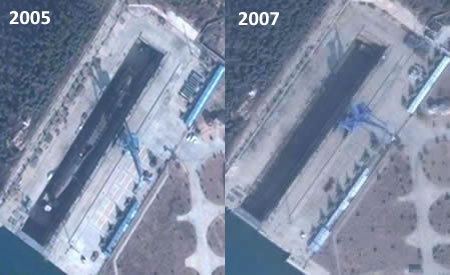 |
| The Xia-class SSBN appears to have completed a multi-year overhaul. The submarine has been in dry dock at least since 2005. Click on image to download large version. |
.
By Hans M. Kristensen
China’s single Xia-class nuclear-powered ballistic missile submarine has been launched from the dry dock at the Jianggezhuang Naval Base where it has been undergoing a multi-year overhaul. The Xia was discovered on a commercial satellite image, which shows the submarine moored in the harbor.
Multi-Year Overhaul
The Xia has been in dry dock at the base since at least 2005, when it was photographed by the Quickbird satellite. A new image, taken on December 5, 2007, and recently made available on GoogleEarth, shows an empty dry dock and the Xia moored on the opposite side of the harbor near the entrance.
|
Figure 1: |
 |
|
The Xia has left the dry dock at the Jianggezhuang Naval Base. Click |
Xia was originally designed with 12 launch tubes for the single-warhead 1,770+-km range JL-1 sea-launched ballistic missile. The Pentagon’s annual report on Chinese military forces lists “10-14” tubes, an odd number given that 12 were visible on the 2005 image. The resolution of the 2007 image is not good enough to count the tubes, but the number is probably still 12. Whether Xia will now finally become operational, serve as a backup for the new Jin-class, or be used as a test launch platform remains to be seen.
The image also shows what appears to be all of China’s five Han-class nuclear-powered attack submarines (SSN), the first of which are being retired and replaced with the Shang-class SSN. One of the five is a little longer than the others and could potentially be a Shang.
The Future of China’s SSBN Fleet
Whether Xia will finally become operational (it has never sailed on a deterrent patrol) or be scrapped remains to be seen. China has begun series production of the Jin-class SSBN, with possibly three launched and one deployed to Hainan Island in late 2007. The DOD has speculated that China might build up to five Jin SSBNs, if it plans to have at least one at sea at any given time. Britain and France each have four SSBNs, with one on patrol.
Background Information: other blogs about China | Chinese Nuclear Forces and U.S. Nuclear War Planning
The FY2026 National Defense Authorization Act (NDAA) paints a picture of a Congress that is working to both protect and accelerate nuclear modernization programs while simultaneously lacking trust in the Pentagon and the Department of Energy to execute them.
While advanced Chinese language proficiency and cultural familiarity remain irreplaceable skills, they are neither necessary nor sufficient for successful open-source analysis on China’s nuclear forces.
Satellite imagery has long served as a tool for observing on-the-ground activity worldwide, and offers especially valuable insights into the operation, development, and physical features related to nuclear technology.
This report outlines a framework relying on “Cooperative Technical Means” for effective arms control verification based on remote sensing, avoiding on-site inspections but maintaining a level of transparency that allows for immediate detection of changes in nuclear posture or a significant build-up above agreed limits.